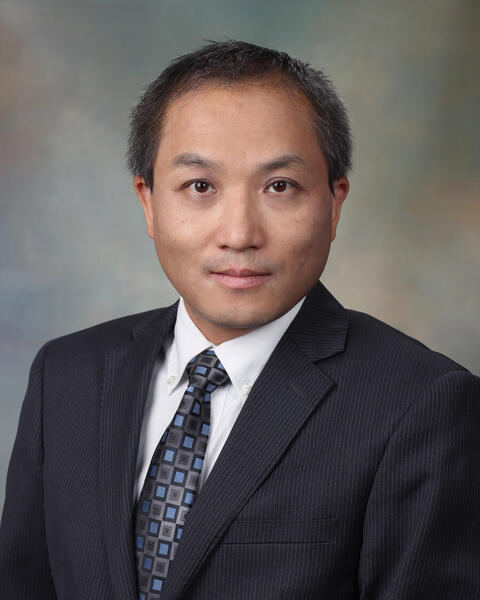PQA 02 - PQA 02 Physics Poster Q&A
2259 - Advanced Solution: Accurate Patient Alignment without Unnecessary Imaging Dose via Synthesizing Patient-Specific 3D CT Images from 2D KV Images
Sunday, September 29, 2024
4:45 PM - 6:00 PM ET
Location: Hall C
Screen: 17

Wei Liu, PhD, MS, BS, FAAPM
Mayo Clinic
Phoenix, AZ
Presenter(s)
Y. Ding1, J. Holmes1, H. Feng2, B. Li3, L. A. McGee2, J. C. M. Rwigema2, S. A. Vora2, W. W. Wong2, D. J. Ma4, R. L. Foote5, S. H. Patel2, and W. Liu2; 1Department of Radiation Oncology, Mayo Clinic Arizona, Phoenix, AZ, 2Department of Radiation Oncology, Mayo Clinic, Phoenix, AZ, 3Arizona State University, Tempe, AZ, 4Mayo Clinic Comprehensive Cancer Center, Rochester, MN, 5Department of Radiation Oncology, Mayo Clinic, Rochester, MN
Purpose/Objective(s): In radiotherapy, image-guided patient alignment is essential for accurate treatment plan delivery. When 3D on-board imaging (OBI) is unavailable, two 2D orthogonally projected kV images are usually used. However, the visibility of the tumor in kV images is restricted due to the projection of the patient’s 3D anatomy onto a 2D plane, potentially leading to substantial setup errors. Although some proton centers have 3D OBI (typically, cone-beam-CT(CBCT)), the field of view of CBCT is limited with unnecessarily high imaging dose, thus unfavorable for pediatric patients. A possible solution is to reconstruct the CT from the kV images obtained at the treatment position. Materials/
Methods: A dual-model framework built with hierarchical vision transformer blocks is proposed with primary and secondary models focusing on the reconstruction of the whole CT and head region, respectively. Unlike a proof-of-concept approach, the daily kV images were considered as the sole input. We collected the kV images and CT-on-the-rails (CToR) from 10 patients with head and neck cancer and registered them to the same coordinate. To utilize noisy and ultra-sparse kV images, a data augmentation strategy termed as geometric property-reserved shifting and sampling is proposed, which simultaneously shifting and resampling the kV and CToR considering the geometrical relation between treatment couch and kV imaging system. Finally, a synthetic CT (sCT) of full size (512512512), desirable for clinical applications, was be obtained by spatially stacking the small size sCTs generated by both the primary model and secondary model. The sCT was evaluated using mean absolute error (MAE) and per voxel absolute CT number difference volume histogram (CDVH). Gamma analysis of the CT numbers comparing sCT to gCT was done. Forward dose calculation was performed on the sCT and gCT using the same plan and compared using 3D Gamma analysis. The robustness of the sCT against shifts was tested through simulations mimicking patient alignment during treatment, where the model predicted the shifted sCTs given manually shifted kVs as input and compared with calculated shifted gCTs. The shifts’ difference between the shifted sCT and shifted gCT was calculated as the shift error (SE).
Results: The proposed approach 1) synthesizes full-size 3D CT in real time (within milliseconds) 2) achieves high image quality (MAE<45HU, CDVH: <5% of the voxels had a per voxel absolute CT number difference larger than 128HU), 3) obtains high dosimetric accuracy (3D Gamma passing rates (2%/2mm/10%)>97%, (3%/2mm/10%)>98%, (3%/3mm/10%)>99%), and 4) is robust to patient position uncertainty (SE <0.4mm).
Conclusion: The proposed framework can generate accurate CTs faithfully mirroring real-time patient position, thus simplifying the procedure of image-guided patient alignment, keeping imaging dose minimum, and maintaining the treatment veracity.
Purpose/Objective(s): In radiotherapy, image-guided patient alignment is essential for accurate treatment plan delivery. When 3D on-board imaging (OBI) is unavailable, two 2D orthogonally projected kV images are usually used. However, the visibility of the tumor in kV images is restricted due to the projection of the patient’s 3D anatomy onto a 2D plane, potentially leading to substantial setup errors. Although some proton centers have 3D OBI (typically, cone-beam-CT(CBCT)), the field of view of CBCT is limited with unnecessarily high imaging dose, thus unfavorable for pediatric patients. A possible solution is to reconstruct the CT from the kV images obtained at the treatment position. Materials/
Methods: A dual-model framework built with hierarchical vision transformer blocks is proposed with primary and secondary models focusing on the reconstruction of the whole CT and head region, respectively. Unlike a proof-of-concept approach, the daily kV images were considered as the sole input. We collected the kV images and CT-on-the-rails (CToR) from 10 patients with head and neck cancer and registered them to the same coordinate. To utilize noisy and ultra-sparse kV images, a data augmentation strategy termed as geometric property-reserved shifting and sampling is proposed, which simultaneously shifting and resampling the kV and CToR considering the geometrical relation between treatment couch and kV imaging system. Finally, a synthetic CT (sCT) of full size (512512512), desirable for clinical applications, was be obtained by spatially stacking the small size sCTs generated by both the primary model and secondary model. The sCT was evaluated using mean absolute error (MAE) and per voxel absolute CT number difference volume histogram (CDVH). Gamma analysis of the CT numbers comparing sCT to gCT was done. Forward dose calculation was performed on the sCT and gCT using the same plan and compared using 3D Gamma analysis. The robustness of the sCT against shifts was tested through simulations mimicking patient alignment during treatment, where the model predicted the shifted sCTs given manually shifted kVs as input and compared with calculated shifted gCTs. The shifts’ difference between the shifted sCT and shifted gCT was calculated as the shift error (SE).
Results: The proposed approach 1) synthesizes full-size 3D CT in real time (within milliseconds) 2) achieves high image quality (MAE<45HU, CDVH: <5% of the voxels had a per voxel absolute CT number difference larger than 128HU), 3) obtains high dosimetric accuracy (3D Gamma passing rates (2%/2mm/10%)>97%, (3%/2mm/10%)>98%, (3%/3mm/10%)>99%), and 4) is robust to patient position uncertainty (SE <0.4mm).
Conclusion: The proposed framework can generate accurate CTs faithfully mirroring real-time patient position, thus simplifying the procedure of image-guided patient alignment, keeping imaging dose minimum, and maintaining the treatment veracity.
